“It’s the quietest 5.56 ever,” the guy at Silencer Shop boasted. I’d stopped by their Austin, TX HQ to borrow something for review. But I didn’t walk in with an idea of exactly what I wanted to check out. An integrally-suppressed AR-15 upper receiver that’s as quiet as a supersonic 5.56 has ever been? Yup. Sign me up . . .
Naturally, the first thing I did was take it apart (yes, it’s the very rare 5.56 can that disassembles for cleaning). That’s it? Color me surprised to see such a tiny, monocore baffle design in there. The core is 6AL4V titanium and the tube is titanium as well.
Not only is it small — about six inches long — but the core effectively has just two full baffles plus the “end cap.” This is GEMTECH’s patented “G-Core Technology.” For those who don’t think suppressor manufacturers are using computational fluid dynamics programs and other tech to model gas flow, guess again.
The INTEGRA (why am I yelling?) comes with a disassembly tool, but that square hole in the front of the monocore conveniently accepts a standard 3/8″ socket wrench, too. Lefty loosey to remove it from the threaded muzzle on the 10.5″ barrel that’s hiding down inside of the tube.
Also worth noting are the four small ports in the front of the 5.56 INTEGRA’s core. Those apparently vent gases from inside the muzzle chamber area, and do so at an angle that imparts a clockwise spin to the core. Basically, it’s self-tightening.
As cleaning the inside of the tube on an integrally-suppressed upper — if it can be cleaned — can be a herculean feat, the INTEGRA’s core has a nifty feature engineered right into it. Both the top and the bottom are designed with a near full-length carbon scraper edge facing in the anticlockwise direction. Unscrewing the core, which means causing it to spin inside of the tube, scrapes the inside wall clean. Carbon deposits are shaved off and come out with the core.
While the core clearly fits very snugly and precisely inside of the tube, it’s intentionally left “open” at the rear. Gas and pressure are free — encouraged, really — to flow backwards over the barrel and take advantage of the absolutely massive expansion chamber that exists from the core’s first baffle all the way back to the gas block.
And what a nice gas block it is. The “GEMTECH / NEMO Arms patented gas block” does double duty as the suppressor tube’s rear cap. In fact, the gas block and the cap are one-in-the-same, machined from a monolithic piece of what I assume is titanium as it’s very nicely TIG welded to the Ti tube. It doesn’t get cleaner than this.
The gas system is pistol-length, but forget about timing issues or excessive gas to the face. Since this upper was built to run exclusively suppressed, the gas port sizing was tuned just right. Or, perhaps it’s getting its gas pressure from inside of the tube instead of bleeding it off of the barrel. I actually can’t say for sure, but I can say that the result is a smooth-shooting, perfectly sorted AR-15 with less blowback gas than any other suppressed 5.56 AR I’ve shot.
Actually, that isn’t the end of the story. At first I wondered why the barrel was so heavy (thick) between the receiver and the gas block, but later learned that GEMTECH has managed to incorporate a functioning bore evacuator into the INTEGRA’s barrel.
That’s right! Similar to the system used on tanks to prevent cartridge combustion gases from coming back through the breech and killing everyone in the tank, GEMTECH has built bore evacuation into the INTEGRA. As demonstrated in the animation above, the point of this system is to suck the gas and debris from inside of the barrel’s bore out through the muzzle, whereas without it the opposite happens. In addition to proper gas system tuning, this system explains a huge part of the INTEGRA’s gas-to-the-face-free, quiet experience.
Thanks to the permanently-attached tube, the legal “barrel” length of this upper — in both 300 BLK and 5.56 — is 16.1″. So it’s a one-stamp set-up (it’s a suppressor, but it doesn’t make an SBR).
Inside the VLTOR Modular Upper Receiver is VLTOR / BCM charging handle and a Ballistic Advantage bolt carrier group. Barrel manufacturer isn’t specified, but Ballistic Advantage makes great barrels (I run their 8.3″ BA Hanson on my 300 BLK SBR) and it’s certainly possible GEMTECH went with BCG and barrel from the same shop.
Ahead of that extremely nice receiver is a 15″ Seekins Precision handguard with full-length top rail, MLOK slots on the sides and bottom, and QD sockets front and rear on the sides and bottom.
All of these non-GEMTECH-manufactured components are not only high quality, but they work together seamlessly. Fit, finish, look and feel are exemplary.
Out on the range it all came together quite nicely. Shooting inexpensive CapArms “Superior Range Ammo” it’s fair to say I was quite surprised by just how quiet the INTEGRA is. Yes, despite the hype.
Look, I don’t shoot a .223/5.56 AR-15 without ear protection. I chalked it up to the supersonic crack of the bullet simply being too loud or at least too uncomfortable, and maybe the AR sending too much gas and pressure back through the action. Naturally, I began my first range session with the INTEGRA with plugs in place. It seemed quiet. Very quiet.
Removing the plugs subjected me to the INTEGRA’s full, ~131 dB (with 5.56) average volume level. Which, for the first time, really sounded like it was all supersonic bullet noise. It seemed like the loudest sound itself was coming from out in front of me — a crack seemingly generated some 15+ yards downrange. I could clearly hear that sonic boom traveling towards the rock wall 500 yards distant, then the sound of the bullet impact making its way back to me.
On that and the next range outing I actually shot without plugs quite a lot, even plopping down for accuracy testing without going back to the ear pro. In fact, I was listening to talk radio on my cell phone’s speaker the entire time. A pleasant range day for sure.
I got the INTEGRA nicely rested and generally sighted in with the CapArms range fodder, then grabbed a box of their 60 grain V-Max and shot a five-round group at 100 yards. Sure, it’s only a 10.5″ barrel and match accuracy isn’t exactly a top design parameter, but group at 100 yards it did.
IMI’s 77 grain 5.56 Razor Core shot slightly tighter groups.
Followed by a couple groups with the superlative 69 grain Federal Gold Medal Match.
Even with me behind the trigger, the INTEGRA is fully capable of 1 MOA, five-shot groups and it’s doing that in a hearing-safe, 16″ barrel length equivalent package.
Right off the bat — the first rounds through this new INTEGRA — I suffered some feeding problems. It was pretty dry in the upper and seemed like the BCG was a bit slow. At some point through the second magazine it began running smoothly and confidently, though it still exhibited a failure to feed or to return completely into battery once every other mag or so. It never failed to lock open on empty, so I do believe the carrier was receiving enough gas to cycle fully.
Before the next range outing I lubed the BCG and swapped lowers, as Silencer Shop had warned me that the upper doesn’t play well with some ambi bolt release lower receivers. In this particular case I think it was just a little lube that did the trick, as another 150 rounds went downrange without a single hiccup.
The smooth recoil indicates a well-tuned gas system. Combined with the bore evacuation system there’s a distinct lack of gas and debris to the face. There’s also less gas- and pressure-induced noise escaping the action than I’m used to with a suppressed AR. Overall the INTEGRA runs smoothly and precisely, with none of the violent cycling exhibited in most ARs when a suppressor is simply slapped on the business end.
It also balances nicely without feeling nose-heavy, as the complete upper weighs five pounds dead-on and the titanium core accounts for precious little of that. Basically, it’s around a half pound heavier than a standard, 16″ barrel complete upper with long handguard and M16 profile BCG. While out on the range shooting offhand and transitioning between targets, the INTEGRA feels solid and purposeful, but not heavy or slow.
Airspace between the tube and the handguard is relatively limited, but a single mag dump didn’t get things uncomfortably warm. Turning two full mags into [limited] noise and smiles? You’ll want a glove for that business, and will likely find your support hand starting to migrate closer to the receiver and farther from the suppressor tube. In my normal range day use the heat didn’t come into play. I’d gladly run this upper in a 3-Gun match, too. Out on a hog hunt? Absolutely. Apparently the INTEGRA is in use by Special Forces (UK, I believe?) now as well.
While it isn’t actually the quietest 5.56 AR-15 setup ever, it likely is the quietest one of its length. 131 dB on a 10.5″ barrel is unheard of, and GEMTECH has done it with a single tax stamp. The INTEGRA’s core is also easily removed for cleaning and the gas system is tuned just so. That, combined with the bore evacuator, kept the action extremely clean — basically right on par with a well-tuned, non-suppressed AR. Impressive.
Specifications: GEMTECH INTEGRA 5.56
Caliber: 5.56×45 (also available in 300 Blackout)
Action: direct impingement, non-adjustable gas block integral to suppressor tube, bore evacuator system
Rifled Barrel Length: 10.5 inches (10 inches in 300 BLK)
Twist Rate: 1:7
Total Effective (legal) Barrel Length: 16.1 inches
Weight: 5.00 lbs
Suppressor Materials: 6AL4V Titanium monocore, titanium tube
Rated Volume Level: 131 dB (128 dB in 300 BLK)
Parts Included: Complete, ready-to-run upper with BCG and charging handle
MSRP: $1,999 (~$1,855 on Silencer Shop, who is the exclusive retailer and distributor. Available via Silencer Shop and their dealer network)
Ratings (out of five stars):
Reliability * * *
Honestly, if it were lubed from the factory it probably would have run without a hitch from the factory. Plus I ignored Silencer Shop’s advice that ambi bolt release lowers might not play well with this upper. After the first mag it ran okay, with a feeding issue about once every other mag. After lubricating the BCG and swapping lowers, it ran absolutely 100 percent with four brands of ammo. I’d need a couple months with the INTEGRA to really rate its reliability with high confidence, though, so we’ll call it average.
Accuracy * * * *
1 MOA isn’t anything groundbreaking these days, but to do it out of a 10.5″ shorty barrel, suppressed, is impressive. Even with cheap plinking ammo I was consistently in the 2 to 3 MOA range and never shot anything over 3 MOA.
Sound * * * * *
Probably the quietest “SBR” AR-15 ever. Especially at the shooter’s ear, thanks to the lack of noise out the action, the INTEGRA is amazingly quiet.
Design * * * * *
From the carbon-scraping core that’s easily removed with a socket wrench (heck, just the fact that it’s a take-down 5.56 can in the first place) to the bore evacuation system and the incredibly clean, monolithic gas block / suppressor tube rear cap, the design of the INTEGRA is extremely well thought out and innovative.
Overall * * * * *
It ain’t cheap, but it’s definitely effective, well made, and innovative. Fit and finish are awesome and all of the parts were chosen and assembled with care. The INTEGRA is compact, yet industry-leading quiet, and as clean and gas-free as it gets. It’s a hell of an upper receiver.

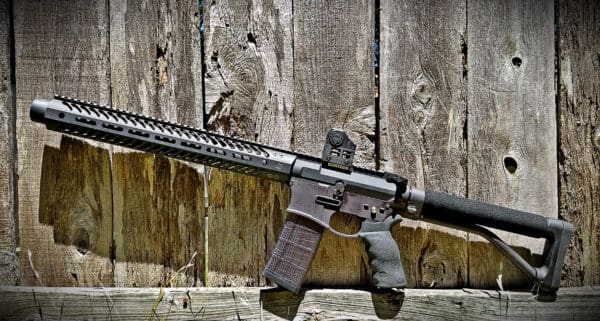
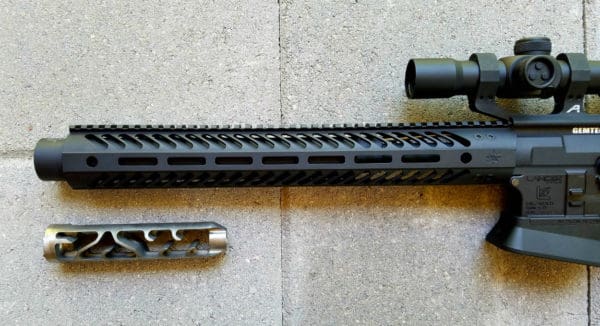

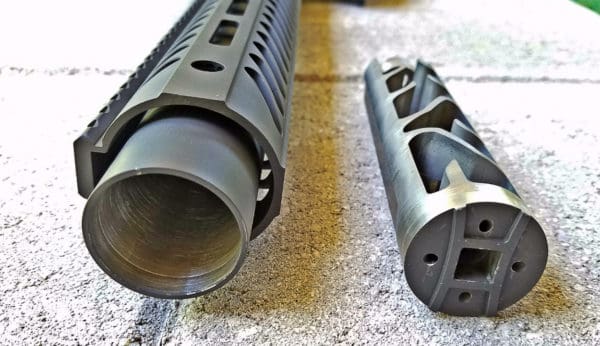

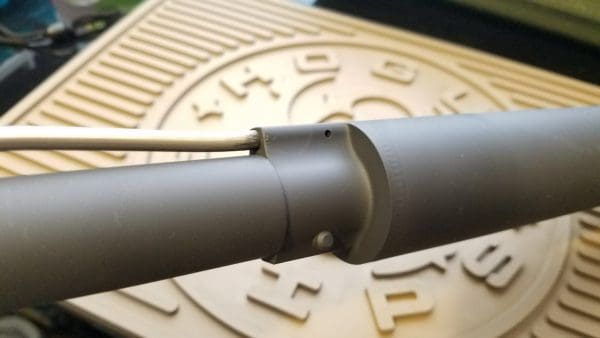
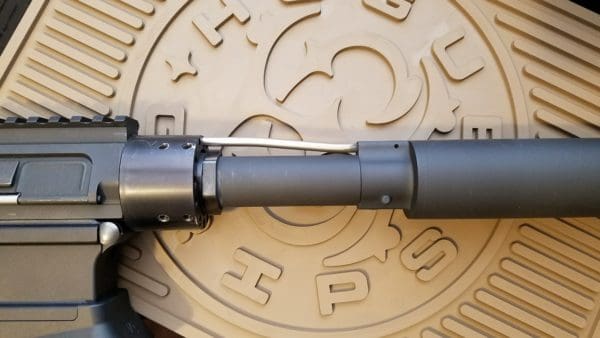


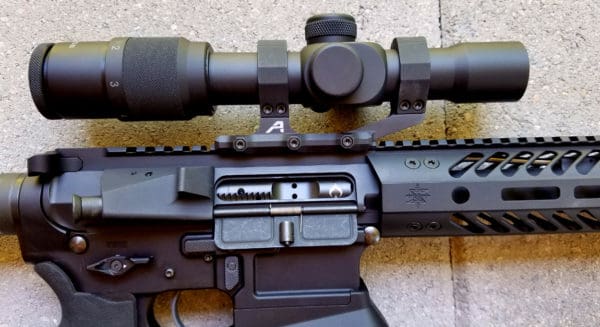
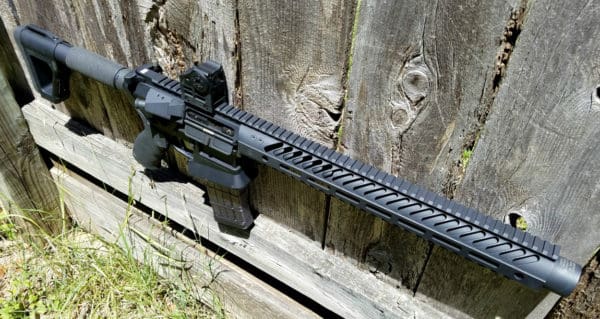
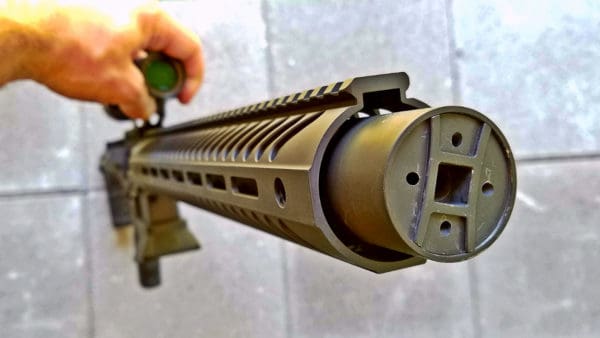
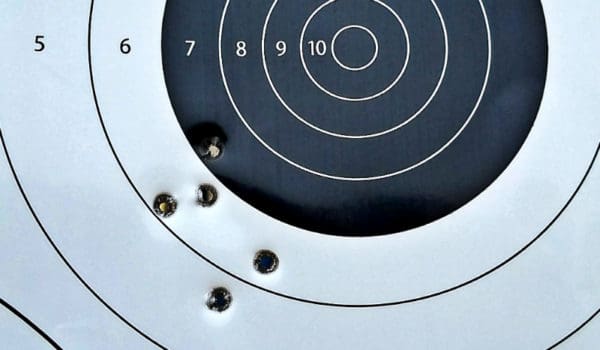
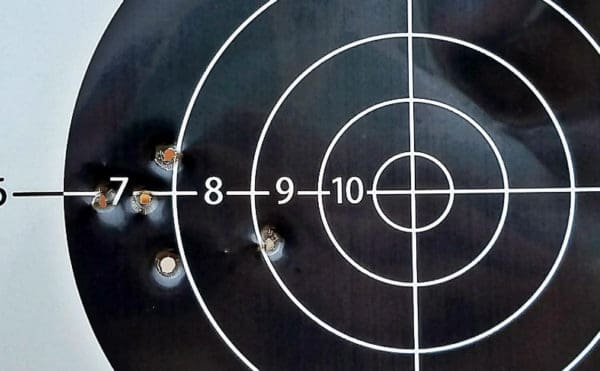
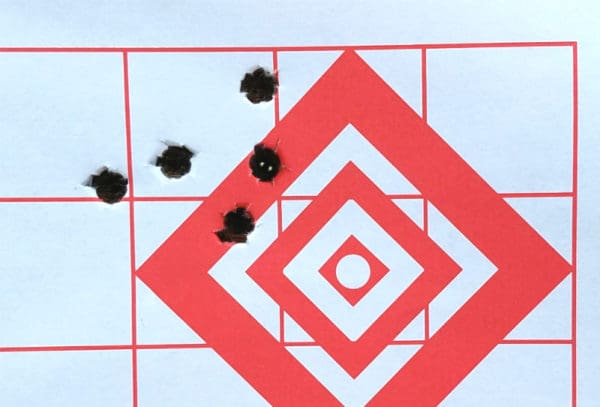







damn 2K that aint bad at all. still, i think im going with a AUG or TAVOR in 300
I do love my Tavor!, but slap a suppressor on the end of it and it’s longer than a 16″ AR (stock collapsed) like you’d have with the INTEGRA setup (and it’s gassy). Then, of course, using an AR lower just opens up a zillion opportunities for tweaking and having multiple uppers, etc etc. An integral Tavor would get my attention!
(Sends link to wife and kids with note that Father’s Day is coming up…)
But it still makes noise! Hollywood (who never lied to me and raised me from a wee lad) says they go ‘pffft’. Must be defective.
:sarc:
Vaguely related… I saw “The Girl With All the Gifts” last night (it’s a zombie flick), and damned if they didn’t actually get suppressors right.
It’s the first show I recall seeing where suppressed rifle rounds sounded exactly like suppressed rifle rounds. None of this “pew-pew” business. Plus it was a pretty good movie in its own right.
What about chrono testing? How do the velocities compare between this, and a normal/unsuppressed 16″ barrel? i.e., what am I giving up performance-wise, to get it quieter?
Apologies for the oversight, but I didn’t think to chronograph it! I should be able to borrow it again if people are really curious. If you are, sound off here so I know.
However, I don’t see any reason to expect velocities to be materially different than a 10.5″ barrel unsuppressed AR at all, and there’s tons of info on velocities at various barrel lengths readily available (hit up ballistics by the inch for starters). This thing isn’t bleeding gas out a ported barrel to drop velocity or anything…it’s a 10.5″ bbl AR-15 with a suppressor that has tons of volume in it. I’d guess velocities are within 1% of what you’d see in an unsupressed 10.5″ bbl setup…
Ugh. No thanks. So it’s all the compromises of a short-barreled .223, but the length of a full-barreled .223. Sounds like an utterly terrible combo.
Sounds like it would be perfect in .300 BLK though.
I’d certainly guess that INTEGRAs in 300 BLK will outsell 5.56 in a very big way. I don’t know which caliber(s) it is that the special forces groups allegedly use. But that’s a great barrel length that achieves a full burn in many 300 BLK cartridges and this setup in 300 is the quietest 300 Silencer Shop has metered. So that’s all good stuff.
Your comparo is tough to accept, though. In this case you have a 16″ length that’s hearing safe. That isn’t the same as having a 16″ barrel that isn’t hearing safe or a 16″ barrel plus a 7″ suppressor or a 10.5″ barrel without a suppressor. This setup will have the velocity disadvantage of a 10.5″ barrel with none of the extra length disadvantages of slapping a suppressor to a full-length barrel yet it meters at only 131 dB. Whether this is good or bad or what depends on how you value length, sound, and velocity for your planned use.
FWIW, here’s .223 speeds (PMC 55gr FMJ) with a 10.5″ 1:8 FN barrel with a Gemtech M4-2 silencer
2482, 2540, 2478, 2433, 2485, 2505, 2496, 2496, 2525 AVG – 2493.3 fps SD – 30.42
While the M4-2 is not monocore, I would expect speeds to be somewhat the same…
Depends on the bbl length (rifled portion) not the suppressor in itself. Adding a suppressor might help gain a few fps (gas pressure is contained). Shorten a bbl (say 9″) then attach (weld) a permanent suppressor will definitely effect vel..
The guy keep muzzling me!
Glad you post videos with silencer reviews.
I was also hearing bullet impact that seemed rather loud. (I wear headphones in the shop)
I could see buying this – automatic $200 saving by just needing one Stamp.
So it’s a $2200 setup that can be had for $1850 from SilencerShop.
I like how you think.
Two thousand dollars
It probably costs them 200 bucks to make this, so that’s a reasonable markup, right?
Bunch of goddamned thieves, but at least the fools who actually do waste the money on these will have something exclusive since so few people are dumb enough to pay that price.
Keep up the great work gemtech
I wish I could say your willful ignorance of actual manufacturing costs was shocking, but sadly it’s not. Go into business for yourself and manufacture a product, then come back to me and tell me how cheap it is to make something.
Yeah I gotta say, that $200 cost statement is completely absurd. Even if you completely ignore development costs and amortized equipment, rent, employment, insurance, etc etc costs and look only at raw materials, machining hours, and finishing costs you’re way, way, way over $200.
In .458SOCOM I would be very interested.
Mmmm, indeed!
” For those who don’t think suppressor manufacturers are using computational fluid dynamics programs and other tech to model gas flow, guess again.”
Oh, yeah. Things are gonna be real nice if the HPA gets passed.
Manufactures will start throwing serious money at computational flow proven designs.
There’s gonna be serious competition for ‘quietest’ bragging rights, and we the buyers will reap the rewards…
So you forgot to lube the bolt carrier and upper reciever and then when I chokes you give it 3 stars for reliability? This isn’t your first gun. And I’m willing to bet not even your first new AR. Lube should be the first thing you do to a new gun. And you know better.
Stay Classy.
I shoot things straight out of the box unless the owners manual says otherwise. The manual here didn’t say anything about it (many manuals DO say something like “ships with corrosion protection applied, before shooting clean and lubricate”) and in those cases I expect things to come ready-to-shoot. Do you think that’s the wrong approach? Happy to be convinced otherwise, but I think I use a particularly good gun lube and if I’m stripping and cleaning and lubing every tester gun that comes through here it may not mirror the experience most buyers would have, which is the main goal. At minimum, I found that it ships dry and seems to benefit from a brief break-in period, which is information prospective buyers should know so they can skip the learning curve I experienced.
That’s bullshit and you should know better. Guns need lube to run effectively, the manual shouldn’t have to say it. Just keep some oil in it and tell us how reliable it truly is, not this “AR torture test” BS that you seem to be doing.
Jeremy,
Know you said “that’s the way I do it.” I’d encourage you to rethink the process for safety, if nothing else.
Can’t tell you how many times after my car gets serviced that I’ve found tools left under the hood by “professional” mechanics, or hoses not tightened down, or oil not topped off, or loose oil filters. Professionals do make mistakes.
In the case of firearms, that could be fatal. Before shooting a firearm I always field strip it, clean and lube it and check for function. That allows me to check the barrel for obstructions, and for any metal shavings or manufacturing flaws before I find them the hard way. It also helps me familiarize myself with the fit, form and function of my new firearm.
Lots of experienced shooters in this forum, but some newbies too. Would think you’d be an advocate of getting to know the basics of every gun you use. One of the ways to do than is cleaning and lubing it according to the manual, and checking the barrel for obstructions each time before first use.
Keep up the great work. Hope this makes sense to you. Minor quibble, and if you don’t think it makes sense or safer shooting, c’est la vie. Be well. JC
excellent reply and absolutely correct.
Okay, I hear you guys. Some years ago we decided that review guns would be run per manufacturer instructions, and if there was no instruction specified to run it right out of the box (which doesn’t preclude a safety inspection, btw). Most guns are cleaned and lubed by the manufacturer before shipping, after being test fired. FWIW I’ve had comments on reviews like “everyone knows you need to polish the feed ramp on these guns before they run well”…and, yeah, sure, but we have to review the gun that the manufacturer ships out to stores, right? At some point it was decided that this would apply to how it was lubed by the manufacturer, unless the manufacturer specified otherwise. We’ll revisit protocol.
The very most important thing, though, is that the goal of our reviews is to provide the most honest and thorough overview of something so that, if you went out and got one, the review would mirror your experience as closely as possible. No surprises and you know what you’re getting into. THAT’S a good review. If you think field stripping, cleaning, and lubing review guns prior to testing them out better mirrors what the majority of purchasers would do we’ll revisit our process. In this case I noted in the review that it was dry when received, noted that it didn’t run well as received, and then noted that I went ahead and lubed it and had a smooth experience afterwards. So you know all the details and can weigh the importance of it however you please.
Lots of guys on the TTAG forum purport to speak for more than themselves. I do not. However, I was raised with a healthy respect to “trust, but verify” and keep my guns clean and lubed. Although I was a Naval Aviator warrior by trade, I just carried a pistol in combat in my flight vest.
Mid-career, I got tapped for a tour with JSOC, and the Tier One guys always stripped and lubed new guns, or guns new to them. Also they looked at them before every trip to the field, no matter if they just did it the night before. No claims to be a SOF Ninja, I just served with ’em and respect the hell out of them and their ways.
IMHO, guns can pick up grit and packaging debris in shipping just like pocket carry guns will. I consider cleaning and lubing not only a safety issue (although you said a safety inspection is allowed and that is great!), but leveling the field. All guns start with the same level of cleanliness, so FTE, FTF, or other malfunctions cannot be claimed on a dirty gun out of the starting gate. Makes it definitely a bang stick issue.
I’ll respect the TTAG guys decision no matter what you decide. Thanks for being willing to consider other perspectives. Be well and safe shooting.
I know you were breaking the sound barrier, but did I see that you were shooting in somewhat of a walled canyon/shooting lane? Were we hearing some of an echo at the same time? Did you fire any subsonic?
It’s a pretty darn large area but, yes, I’m sure there’s some echo and there’s also a sheet metal shade structure where I’m standing in the vid and that’s good for some noise reflection also.
Subsonic .223 really isn’t a thing.
https://www.thetruthaboutguns.com/2010/12/robert-farago/subsonic-extreme-shock-223-ammo-ar-as-quiet-as-an-airgun/
Bob Farago thinks it is.
Yeah it exists from like three little niche companies but it isn’t a “thing.” I actually think we have some coming for testing soon that’ll allegedly cycle a standard AR-15 action, which seems hard to believe. But to do subsonic in even a 90-ish grain 5.56 you have to remove so much powder that you’re practically shooting a .22 LR. It’s just worlds away from what the caliber was intended to do. Whereas things like 9mm are subsonic within the standard bullet weight and powder charge range and 300 BLK was designed around having a heavy bullet subsonic and light bullet supersonic, etc…
Great explanation, and I should have pulled up some charts on the energy. Sorry. Just pulled up the TTAG article.
Haven’t shot anything subsonic in a long time other than some .22 CB shorts in a pump. Thanks.
Jeremy S., permanent hearing loss occurs after 15 minutes of exposure to 85 decibels, and you state that you cheerfully exposed your ears to 131 decibels. You may have already done permanent damage to your hearing.
You may wish to read my recent TTAG post, “Today’s Hearing Protection Doesn’t Work”, so you don’t wind up like me,but I fear it may be too late.
Degeneration in the inner ears is usually slow, like the decades-long clogging of our arteries that causes heart attacks. You can Google everything I just said and check it, you can think about it, you can talk about it, you can study it, you can understand it…but so what? None of those things will bring your hearing back after you’ve ruined it.
Bro, do you even OSHA?
First – there’s a difference between peak levels and average (RMS) levels as it relates to damaging your hearing. Average levels are time-weighted, and OSHA/NiOSH say you can work in a noisy environment with an average of 85dB SPL A-weighted for 8 hours/day for 40 years and not incur significant hearing damage.
For transient or peak levels, the threshold for hearing damage is 140dB SPL. I’m not sure if that’s A-weighted or C-weighted, but I would imagine the low-frequency impact has an important part to play in it.
Now granted, these are averages, and some people have a different threshold of hearing/pain than others, and some other health concerns could play into a higher sensitivity for damaging the cilia in your inner ear. I’m really sorry that you’ve experienced hearing loss, but please check your 15-minutes at 85dB SPL reference.
“Hearing safe” for impulse noises is 140 dB, as mentioned above. Some people use a 136 dB measurement but OHSA says 140. I 100% agree with you that you should wear hearing protection AND use a suppressor. That’s what I do 99% of the time. The other 1% is when I’m shooting something that’s rated hearing safe for a review and I subject myself to it so I can speak to its sound. Even then I try not to shoot many rounds without ear pro — just enough to come up with a solid opinion of what it sounds like. In this case, yeah, I admit I shot more than usual without ear pro and more than I had to strictly for review purposes.
…actually when shooting suppressed, subsonic .22 LR I prefer to go without ear pro. Outdoors that’s basically as quiet as dry firing from behind the gun.
I am a big fan of the reviews at TTAG and Jeremy’s reviews in particular, but I would really appreciate more data on the accuracy of firearms. Reporting on one or two five-shot groups is not very useful. Most any rifle can occasionally produce a 1 MOA group. The capability of producing one such group does not make it a 1 MOA rifle or indicate much about its accuracy. It would be nice if TTAG settled on a standard for reporting accuracy that involved publishing the results of 10 to 20 5-shot groups. That would be much more helpful.
I’d love that but the ammo budget really isn’t there. Five, five-round groups with three or four different brands and weights of ammo is awesome but it’s a lot of ammo and in some calibers that’s $$$$$. We’ve done it a handful of times in 9mm and .22 LR and sometimes .223 but it hasn’t really changed the average. I shot two groups each with four brands of ammo through the INTEGRA and each pair was extremely consistent. For example, the two Federal Gold Medal groups pictured here are nearly identical. One was 1.04 MOA and one was 1.066 MOA. I’m pretty sure I could do 10 of those groups and they’d cluster really tight right about that same measurement.
This is good feedback though. When we get guns in that have accuracy billed as their #1 most important feature, I think we can up the accuracy group testing count. Accuracy is well down the list of selling points on the INTEGRA so it probably warrants a more cursory test.
I think all of us can appreciate the issue of ammunition costs. As an alternative, perhaps you could consider reporting all of the groups that were shot, even if it is only eight. I could see how randomly dropping that data into the middle of a review could break-up the flow of the writing, so maybe it could get inserted at the end of each article in the accuracy section. Upon further review, I do now see that you included some additional information on group sizes in that section. Including the specifics for groups would be even better.
If you revisit this gun, could you shoot it left handed? I shoot rifles left handed and since this upper will probably never be offered in a left-side-eject, how it affects someone shooting it from the left shoulder is important to me.
Yes, if I revisit it to do chronograph testing (which I don’t envision doing, but if there’s a clamor for it I will) I’ll shoot it lefty. I should say, though, that it ejects like a standard AR (and very consistently) but has less gas than any suppressed setup I’ve shot but a touch more than a properly-tuned, unsuppressed gun.
It’d take a bit of dedication, but technically you could take the whole suppressed barrel setup and put it on a left hand ejecting upper, then sell off the VLTOR upper and the bolt and such…
just looked up Bore Evacuator on wiki and they call the projectile…the shell. “as the shell moves down the barrel, gasses..”
jesus christ. did a liberal write that?
I think that’s because it’s almost always just a feature of a tank or howitzer barrel, which means the projectiles are “shells” as they can carry a payload. Artillery shells, etc…
Since it has a bore evacuator, does the manual say you have to clean it after so many roads? I was on the M60 and M1 tanks and taking apart the barrel to clean the evacuator wasn’t all that fun,
Should say “clean it after so many rounds” not roads.
I am on the Gemtech Prostaff and also run a college shooting team that has Integras we use for 3Gun.
I have both 5.56 and 300Blk uppers. They are outstanding. The 300 with subs simply has to be shot to be believed.
We recently used the 5.56 Integras in a 3Gun match shot by Service Academies and Senior Military Academies that extended to 300 yards. Running 77 grain OTM the Integras averaged 2450 FPS (chrono at 12′ from muzzle). Holdovers downrange were identical to the holdovers used for our 14.5″ barreled rifles, just slightly more than our 16″ guns.
Accuracy was outstanding. Hits at 300 on 10″ plates got boringly easy once the proper hold over was established with the red dot sights used.
Cleaning, inspecting and properly lubing an upper before shooting it shouldn’t have to be in the manual, but I guess that is the world we live in now…
Bummer. I already have an SBR lower, but that’s the stamp I would NOT need. I’d still have to pay for and wait for the suppressor stamp. Tell ya what! When the HPA is signed, I’ll run right down to Silencer shop and pony up the bucks for the .300 upper. Or have it mailed to me! Damn, just that ability would be worth a bunch to me!
I think Gemtech is to be commended for a very well thought-out piece of engineering. My only concern is the longevity of the system. What happens when you wear out the barrel? Given that the barrel, gas block, suppressor tube and bore evacuator are all linked together, with some parts in fact welded to each other, how do you replace the barrel? If you shoot the system full auto you’ll probably start to see accuracy degradation between 5000-10,000 rounds. Then what? Buy another $2000 Integra?
Gear up as your favorite Delsin Rowe Vest. Slim Fit Leather Jackets brings this iconic jacket from animation to reality, especially for all the fans of this video game. Delsin Rowe is the main protagonist and playable character, a young Native-American man who later realizes he’s a Conduit with special powers.